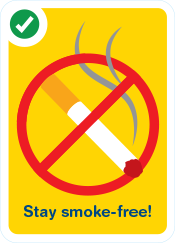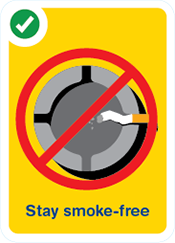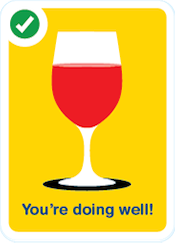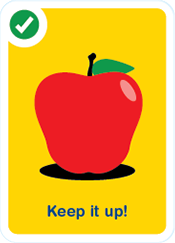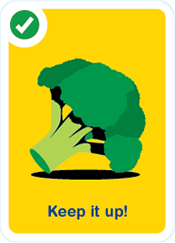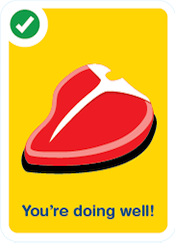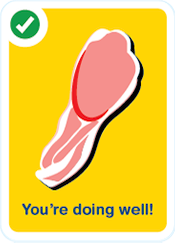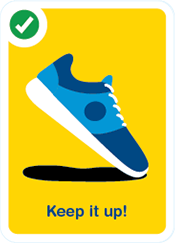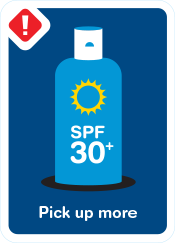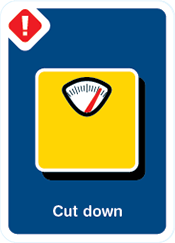Your results: You could reduce your cancer risk by modifying some lifestyle choices
Explore your cards to learn about your risk of cancer:
UV exposure
![]()
- Wear sun protective clothing
- Apply and reapply sunscreen SPF30+ or higher at least every 2 hours
- Stay in the shade
- Wear sunglasses
- Dont’ wear a sun protective hat

Pick up more sun protection
Did you know that UV radiation from the sun causes more than 95% of all skin cancers?
UV radiation comes in different wavelengths called Ultraviolet A (UVA) and Ultraviolet B (UVB). UVA penetrates deeply into the skin causing damage to cells while UVB penetrates the top layer of the skin causing cell damage and is the wavelength responsible for sunburn, a significant risk factor for melanoma.
When UV levels are 3 and above use a combination of sun protection measures to reduce your risk of skin cancer: clothing, sunscreen, hats, shade and sunglasses.
- Slip on clothing that covers as much of the skin as possible
- Slop on at least broad-spectrum SPF30+ sunscreen
- Slap on a wide-brimmed, bucket or legionnaire-style hat
- Seek shade
- Slide on close-fitting wraparound sunglasses
Smoking
![]()
- Never smoked

Excellent! Keep it up
Did you know 1 in 5 cancer deaths are caused by smoking? Well done, you’ve significantly reduced your risk of cancer.
Cigarette smoke contains more than 7,000 chemicals including 69 that are carcinogens (known to cause cancer). When you inhale, these chemicals enter your lungs and spread through your body via blood and lymph systems. This can interrupt normal cell growth, causing cells to multiply too fast or develop abnormally, which can (and often does) result in cancer cells.
Not smoking is the best way to reduce your cancer risk and create a healthy environment for family and friends around you.
Second-hand smoke
![]()
- Have a smoke free home and car

Excellent! Keep it up
Well done. Did you know that 6% of lung cancer cases are caused by second-hand smoke from a partner?
Cigarette smoke contains more than 7,000 chemicals including 69 that are carcinogens (known to cause cancer). When you inhale, these chemicals enter your lungs and spread through your body via blood and lymph systems. This can interrupt normal cell growth, causing cells to multiply too fast or develop abnormally, which can (and often does) result in cancer cells.
When smokers expose non-smokers to second-hand smoke, they inhale many of the same cancer-causing chemicals that smokers inhale.
There’s no safe level of exposure so having a smoke-free home and car is a great way to protect you and your family.
Alcohol
![]()
- Don’t drink

Excellent! Keep it up
Not drinking reduces the risk of 7 cancers.
Alcoholic drinks contain ethanol, which irritates your body’s cells. Over a prolonged period of time (even with moderate amounts), this cell irritation can lead to cancer. Alcohol can damage the lining of the mouth and throat causing cancer in these parts of the body. Alcohol can also impact the levels of hormones that are linked to breast cancer. And when alcohol is digested it can break down into compounds that cause bowel cancer. Your risk of getting cancer increases with every alcoholic drink you consume.
If you don’t drink, it’s healthiest not to start. And by not drinking, you’re also supporting others in being alcohol-free.
Fruit
![]()
- Eat 2 or more serves of fruit a day

Excellent! Keep eating 2 serves of fruit a day
Eating at least 2 serves of fruit each day helps reduce your risk of lung and oesophageal cancers.
Fruit is rich in fibre, vitamins, minerals, antioxidants and phytochemicals which, in combination, help to reduce the risk of certain cancers. Because fruit is rich in nutrients and low in kilojoules, it helps maintain a healthy body weight, adding further protection against cancer. Excess fat around the stomach and obesity are well-documented risk factors for some cancers of the stomach, bowel, breast (post-menopause), oesophagus, liver, kidney, gallbladder, pancreas, endometrium, ovary and prostate (advanced).
Keep it up and start early each day. Top your favourite breakfast cereal with banana, berries or canned fruit such as peaches or apricots.
- Make fruit a go-to snack. Grab an apple, banana or add chopped fruit to yoghurt.
Vegetables
![]()
- Eat 5 or more serves of vegetables a day

Excellent! Keep eating 5 serves of vegetables a day
Nice work. Eating at least 2 serves of fruit and 5 serves of vegetables each day helps reduce your risk of oesophageal, lung, bowel and some mouth and throat cancers.
Vegetables are rich in fibre, vitamins, minerals, antioxidants and phytochemicals which, in combination, help to reduce the risk of certain cancers. Because vegetables are rich in nutrients and low in kilojoules, they help maintain a healthy body weight, adding further protection against cancer. Excess fat around the stomach and obesity are well-documented risk factors for some cancers of the stomach, bowel, breast (post-menopause), oesophagus, liver, kidney, gallbladder, pancreas, endometrium, ovary and prostate (advanced).
Keep it up. Try serving salad at lunch and adding baby spinach, tomato, carrot and cucumber to a sandwich or wrap.
- Make vegetables your go-to snack. Try raw vegie sticks and dip, corn on the cob, or vegie muffins and pikelets.
- Start early in the day. Try baked beans or spinach and tomato on toast at breakfast.
- Vegie-boost your meals. Try reducing meat and increasing vegetables on pizza and in curries, stir fries and mince dishes.
- Make simple changes every day. Try adding salad to sandwiches or having extra vegetables with dinner.
- Vegie-boost your meals. Try reducing meat and increasing vegetables on pizza and in curries, stir fries and mince dishes
Red meat
![]()
- Do not eat red meat

Not eating red meat reduces your cancer risk
Limiting consumption of red and processed meat decreases your risk of bowel cancer.
Current research shows that there are certain naturally-occuring chemicals in red meat that cause it to be carcinogenic. For example, when a chemical called haem is broken down in the gut, N-nitroso chemicals are formed and these have been found to damage the cells that line the bowel, which can lead to bowel cancer.
Add beans, lentils, eggs, fish or chicken to your meals for a protein boost, or sprinkle on some nuts or seeds.
- Try a vegie pattie burger, vegetable lasagne, tofu stir fry or a falafel wrap.
Processed meat
![]()
- Do not eat processed meat

Not eating processed meat reduces your cancer risk
Consuming too much red and processed meat causes 18% of bowel cancer cases.
Processed meat is classified as a Class 1 carcinogen by the World Health Organization. Current research shows that there are certain chemicals in processed meats – both added and naturally occurring – that cause them to be carcinogenic. For example, when processed meat is broken down in the gut, N-nitroso chemicals are formed and these have been found to damage the cells that line the bowel, which can lead to bowel cancer. In addition, the nitrite and nitrate preservatives used to preserve processed meat produce these N-nitroso chemicals and can lead to bowel cancer.
Keep it up. Add egg, tuna or chicken to your sandwich or salad at lunch time for a protein boost.
- Add chicken, mushrooms, eggplant or capsicum to your pizza or pasta
- Try some marinated chicken, grilled fish, vegie kebabs or lentil patties on the BBQ
- In your weekend fry up use grilled tomato, fresh avocado or sauteed mushrooms
Weight
![]()
Based on your height and weight your Body Mass Index (BMI) is 30.9. This puts you in the overweight range.

Being overweight increases your cancer risk
Being overweight increases your risk of 11 different cancers including bowel, pancreatic, kidney and liver cancer.
Excess body weight increases insulin resistance, which causes the pancreas to produce more insulin. Elevated levels of insulin-like growth factor 1 can promote the growth of cancer cells.
Achieve and maintain a healthy body weight within a BMI range of 18.5 to 25 to reduce your cancer risk.
- Cut out unhealthy snacks, and replace them with nuts, fruit, yoghurt or cheese
- Swap sugary drinks for water
- Eat plenty of fruit, vegetables, legumes, wholegrain and high fibre foods
- Limit the portion size of your meals and snacks
Physical activity
![]()
- Are physically active 5-7 days per week

Keep it up. Find more ways to be physically active each day.
At least 60 minutes of moderate or 30 minutes of vigorous physical activity every day reduces your cancer risk.
Besides fighting off weight gain and obesity, physical activity can reduce insulin and insulin-like growth factors which can promote the growth of cancer cells. Exercise also reduces exposure to dietary carcinogens by speeding up food passing through the bowel.
Pick up some more vigorous exercise. Go for a short jog, a fast cycle or do an aerobics class.
- Cut down on screen time, get up from your seat – at home and work
- Choose activities you enjoy, plan ahead or exercise with a friend
- Make a brisk walk, swim or fun in the park part of your daily routine
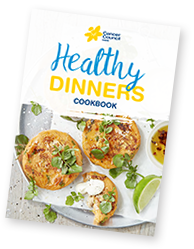 Receive our FREE Healthy Dinners Cookbook packed with healthy recipes and meal ideas when you send your quiz results to your email.
Receive our FREE Healthy Dinners Cookbook packed with healthy recipes and meal ideas when you send your quiz results to your email.
Find out more on how your lifestyle choices can reduce your cancer risk
Share the cancer risk quiz to encourage others to check their cancer risk
